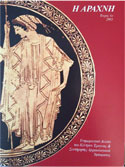Experimental archaeology
Experimental archaeology is a scientific field focusing on the design and implementation of carefully controlled experiments aimed to test research hypotheses regarding ancient techniques and practices. When applying the experimental method, archaeologists reconstruct activities and production processes with replicas of ancient objects and tools, using exclusively the techniques known for each period.
Although it is sometimes linked to experiential archaeology, a practice focusing on the revival of ancient practices (i.e. wearing ancient clothing, performing rituals and/or ancient athletic events etc.) experimental archaeology is different in that it is a valid research methodological tool.
In the case of archaeological textiles, experimental archaeology provides the opportunity to investigate the function of the tools involved in the production process and to test the validity of our research hypotheses concerning these tools and technology more generally. Through these experiments we attempt to answer basic questions such as: What differences lay in the function of various types of loom-weights (if any)? Which type of loom-weight was suitable for a particular kind of thread? Experimental weaving of fabrics similar to the ones recovered from archaeological contexts by the use of a replicated ancient loom, brings us closer to the issues and problems faced by ancient weavers: the techniques applied, the exact use of certain categories of tools, the technological know-how, the body gestures and the skills which are necessary for the operation of the loom, the possibilities and limitations of certain types of looms compared to other types.
The study of ancient textile dyes is another sector of textile archaeology, which benefits from the experimental approach. In recent years a growing number of projects dedicated to experimental natural dye production from plant and animal resources, have considerably enlarged our comprehension of the wide range of dyes available to ancient weavers, as well as our understanding of the techniques involved in the process of dye production.
It is evident that archaeologists engaged in experimental archaeology need to develop a deep understanding of the materials and techniques under research. For example, a good knowledge of textile techniques is essential for any archaeologist embarking on weaving on an upright loom. Likewise, familiarity with pottery making is beneficial for any attempt to manufacture replicas of ancient clay loom-weights or spindle whorls. Collaboration with specialists and craftspeople is therefore a vital component of experimental archaeology.


